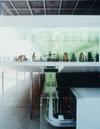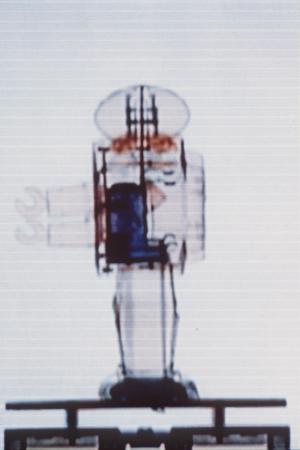MASTER/SLAVE
FONDATIONCARTIERPOURLARTCONTEMPORAIN,PARIS,FRANCE
Czech writer Karel Čapek introduced the word “robot” to the world in his 1920 play R.U.R. (often subtitled Rossum’s Universal Robots). In the public imagination, the robot was a surrogate body that could perform menial tasks, liberating the human to pursue more important endeavors. Yet, as Čapek warned, the dystopian flip side of this fantasy suggested that free-willed, intelligent robots would eventually rebel, inverting the master-slave relationship. The dream, and threat, of technological mastery guides the strategy for Master/Slave, an installation displaying the collection of toy robots amassed by Rolf Fehlbaum, former chairman of the Vitra furniture company. Many of the children’s tin wind-up toys on display were produced in Japan between 1937 and 1973.
The collection inhabits a giant glass vitrine situated in a large glass gallery: a glass box within a glass box. The one-thousand-square-foot vitrine houses the robots in a horizontal space, only eighteen inches tall, with the proportions and atmosphere of an unemployment office in a generic midcentury office building. The vitrine crowds the gallery: viewers are confined to the peripheral space between the vitrine and the building envelope, themselves on display.
The colony of robots parades endlessly along a three-hundred-foot-long conveyor belt originally used in pharmaceutical production. Constantly evading the visitor’s prolonged naked-eye inspection, the robots glide along the winding circuit, stopping at times to pose before various microcameras linked to a closed-circuit network that surveils the robot space. The cameras broadcast real-time video feeds to a bank of monitors positioned along the gallery wall. Precise camera placement prevents any blind zones: the robots are being watched during every moment of their circuit. Visitors are turned into inspectors. The robots temporarily leave their vitrine and are X-rayed at the base of the down ramp. Their mechanical entrails are displayed on an external screen.
- 35' x 35' glass vitrine supported by pilotis

 X-ray view
X-ray view
| Location Fondation Cartier pour l'art contemporain, Paris, France |
| opening30th June 1999 | closed19th November 1999 |
| Team | Elizabeth Diller,Ricardo Scofidio,Lyn Rice,and Stefan Gruber |








